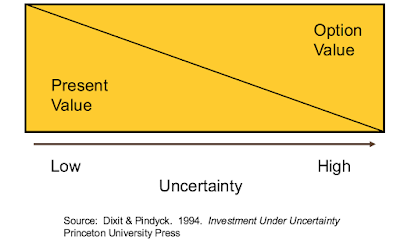Bad” Innovation Is Just What Your Company Needs

http://www.strategy-business.com/blog/Bad-Innovation-Is-Just-What-Your-Company-Needs?gko=cc371&utm_source=itw&utm_medium=20160721&utm_campaign=resp
Interesting article. See the original for great examples of each innovation type.
It’s easy to spot and celebrate the innovations that change company fortunes: Apple’s iPhone, Warner-Lambert’s (and then Pfizer’s) Lipitor, Microsoft’s Windows, to name a few. What is harder to appreciate are those innovations that aren’t the blockbusters and home runs but nonetheless play a critical role in a company’s innovation strategy. I’m not talking about the incremental improvements, but rather the value of launching new products and services that hold tremendous value even though they don’t shoot for the moon.
What follows are four perfectly good reasons, aside from world domination, to pursue innovations.
- Innovation as placeholder. If you already have a dominant position in your market, chances are good that when a new niche product emerges in that space, your company would rather wait to see whether it matures into a clear threat before responding. But that could be a mistake. By the time the impact of that product becomes clear, you may have lost your window to launch a version that will gain traction. Instead, consider developing and launching a me-too product. Think of it as a placeholder to keep customers from straying.
- Innovation as proving ground. Smaller innovation projects can provide important but affordable ways to test new technologies, market opportunities, business models, and emerging talent. The interdisciplinary nature of developing and launching a smaller-scale project, and the reality of its outcome, can plainly show how a product or service is likely to do on the Broadway stage of your market, but with a community-theater budget.
- Innovation as trust building. Backing an innovation isn’t a single decision. It’s a web of choices and actions to which everyone in the company must commit. That commitment is the core of the innovation process and requires enormous trust among coworkers and departments. No amount of talk can substitute for the level of trust that can be built through shared experience. If you wait for the really big innovations to form these bonds, it will be too late.
- Innovation as a long game. For many innovation projects, the need to promise a certain and significant return on investment can doom otherwise viable opportunities. The traditional planning cycle kills projects not because the outlook for them is bad, but because nothing less than an overnight blockbuster will be considered a success. It’s called “giving birth to a 17-year-old” — and the class valedictorian or captain of the football team, at that. Some things just take time. Instead of thinking about whether the first product will be a success, consider whether the first product will enable you to build the right capabilities, understand the market potential, develop key partners, and guide the market toward where you want to be in five years.



